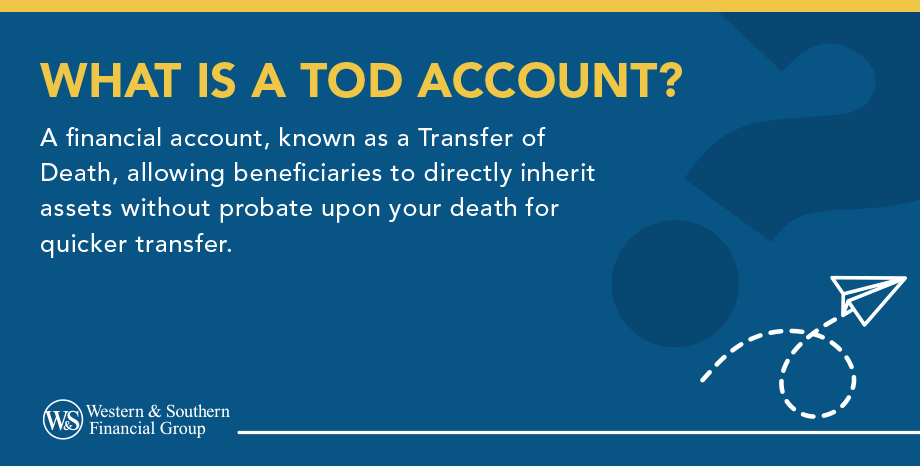

Key Takeaways
- Assets in a TOD account go directly to your named beneficiaries without going through probate, saving time and money.
- You can use, change, or close a TOD account any time; your beneficiaries have no access until after your death.
- Most financial institutions offer simple forms to add a TOD designation to investment or brokerage accounts.
- TOD accounts should be coordinated with your will, trust, and other legal documents to avoid confusion.
- TOD accounts are great for many financial accounts, but real estate, business interests, or minor children may need other planning tools.
When it comes to passing on your assets, clarity and speed matter. Transfer on Death (TOD) accounts offer a straightforward way to name beneficiaries for your investment accounts and other financial assets, without triggering probate.
Whether you're new to estate planning or refining your strategy, understanding how TOD accounts work could help your heirs skip the paperwork and get quicker access to the funds you intend for them.
What Is a Transfer on Death (TOD) Account?
A Transfer on Death (TOD) account is a type of financial account that lets you name one or more beneficiaries who will automatically inherit the assets in the account when you pass away. Unlike a Last Will and Testament, which may require court validation, a TOD account passes outside of probate. That means fewer delays and potentially lower legal fees for your loved ones.
Types of TOD Accounts:
- Brokerage accounts (stocks, bonds, mutual funds)
- Investment accounts (including ETFs and retirement accounts where TOD registration is allowed)
- Some bank accounts (though often referred to as Payable on Death (POD))
- Certain types of real estate (via a TOD deed or transfer-on-death deed, where allowed by state law)
- Certificates of deposit (CDs) at certain banks
- U.S. Treasury securities through TreasuryDirect
- Non-retirement accounts at financial institutions that support TOD features
How Do Transfer on Death Accounts Work?
Setting up a TOD account is usually a straightforward process:
- Open or update your account with a financial institution.
- Request TOD registration (some call it beneficiary designation or TOD registration).
- List your beneficiaries by full legal name and relationship.
- Designate contingent beneficiaries as a backup.
- Upon your death, your beneficiary provides a death certificate to claim the account.
- The financial institution transfers ownership directly to the named beneficiary.
You retain full control of the account while alive. Your beneficiaries have no rights to the account until your death.
Pros & Cons of Transfer on Death Accounts
| Pros | Cons |
|---|---|
| Avoids Probate: Assets pass directly to named beneficiaries. | Possible No Creditor Protection: TOD assets may be claimed by creditors if estate debts exist. |
| Cost Savings: No probate fees, court costs, or executor expenses on these accounts. | Conflicts with Joint Ownership: Joint ownership with survivorship rights can override designation. |
| Speed: Beneficiaries can access assets quickly, often within weeks. | Inheritance Tax: TOD assets often get a step-up in basis, reducing or eliminating beneficiaries' capital gains tax if sold immediately; inheritance tax may still apply. |
| Privacy: Probate records are public; TOD transfers remain private. | No Simultaneous Death Protection: If your primary beneficiary dies and no contingent is named, the asset may go through probate. |
| Flexibility: You can update beneficiaries as life changes. | Limited Scope: Asset types like certain real estate may not qualify due to state laws. |
| Simple Setup: Financial institutions often provide easy-to-use forms. | No Conditions Allowed: You can't set conditions like age limits on distributions. |
| Direct Transfer: No waiting for court approval or executor distribution. | Lack of Coordination: Conflicting TOD designations with your will or trust can cause confusion. |
| Asset Control: You maintain full access to and control over the account during your life. | Unequal Distribution: Naming one child can cause family disputes if others are excluded. |
How Transfer on Death Accounts Fit Into an Estate Plan
Transfer on Death accounts can be powerful tools, but they work best when coordinated with your full estate plan.
Here’s how they complement other tools:
- Last Will and Testament: TOD designations supersede your will for those assets.
- Living trust: Useful for managing multiple assets or setting conditions on inheritance.
- Power of attorney: Important for incapacity planning and managing accounts during your lifetime.
- Estate planning attorneys: Can help align TODs with your broader goals and avoid conflicting instructions.
- Letter of intent: Can help your executor or loved ones understand the role of TOD accounts in your plan.
- Digital asset planning: TOD accounts can be included in a comprehensive plan that covers all asset types.
Be sure to keep beneficiary information current. A tax advisor can also help assess how a TOD strategy could affect your heirs when it comes to estate taxes, capital gains tax, and inheritance tax liabilities.
Transfer on Death vs Payable on Death (POD): What’s the Difference?
| Feature | TOD (Transfer on Death) | POD (Payable on Death) |
|---|---|---|
| Commonly used for | Investment & brokerage accounts | Bank accounts (checking/savings) |
| Asset type | Mutual funds, stocks, bonds | Cash |
| Handled by | Financial institutions | Banks or credit unions |
| Probate avoidance | Yes | Yes |
Transfer on Death Accounts vs. Living Trusts
While living trusts are often used to avoid probate and allow detailed asset control, they require more setup, cost, and maintenance. TOD accounts are a simpler alternative, particularly for individuals with fewer or more straightforward financial assets.
| Feature | TOD Account | Living Trust |
|---|---|---|
| Probate avoidance | Yes | Yes |
| Setup complexity | Low | High |
| Legal Costs | Minimal | Potentially high |
| Covers all assets? | No (financial accounts only) | Yes |
| Can manage during incapacity | No | Yes (via trustee) |
| Works with power of attorney | Limited | Yes |
When to Use a Transfer on Death Account
Transfer on Death accounts may be right for you if:
- You have brokerage or investment accounts you want to pass outside of probate.
- Your estate is relatively simple and doesn’t require a living trust.
- You want to retain full control of your assets during life.
- You’d like to avoid delays caused by the probate process.
- You want to reduce potential conflicts between your will and your financial assets.
- You prefer a low-cost, low-maintenance estate planning tool.
- Your beneficiaries are financially responsible adults.
- Your financial institutions support TOD registrations.
When to Consider Other Options Instead
- You own real estate in states that don’t allow TOD deeds.
- You want more detailed control over how assets are distributed.
- You have multiple beneficiaries or minor children.
- You wish to leave charitable gifts that require documentation.
- Your estate may face estate taxes or creditor protection concerns.
- You worry about beneficiaries mismanaging sudden windfalls.
- Your financial strategy involves closely held businesses or illiquid assets.
Actionable Tips Before Setting Up a Transfer on Death Account
- Confirm TOD availability with your financial institution.
- Consult with a tax advisor to understand potential tax implications.
- Work with estate planning attorneys if you have a complex estate.
- Review beneficiary designations annually and after life events.
- Coordinate TODs with your overall estate plan to avoid conflicts.
- Consider contingent beneficiaries in case your primary beneficiary predeceases you.
- Verify correct spelling and legal names on all TOD forms.
- Ask about account-specific rules on TOD options (some may have restrictions).
- Document and share your intentions with loved ones to avoid future confusion.
- Update other documents (like your will or trust) to reflect your TOD choices.
Final Thoughts: A Simple But Powerful Estate Tool
Transfer on Death (TOD) accounts offer a streamlined way to pass on your financial assets while skipping the headaches of the probate process. They're not a one-size-fits-all solution, but when used strategically, they can add speed, privacy, and efficiency to your estate planning toolbox.
Whether you're managing bank accounts, brokerage accounts, or mutual funds, TOD registration helps you stay in control while simplifying things for those you leave behind.
Add a TOD account to help simplify future asset transfers. Start Your Free Plan
Frequently Asked Questions
Can multiple beneficiaries be named on a Transfer on Death (TOD) account?
Do Transfer on Death (TOD) accounts impact Medicaid eligibility?
Can a Transfer on Death (TOD) account be challenged in court?
Are there fees involved in setting up a TOD account?
Can a Transfer on Death (TOD) account be used for charitable giving?
Sources
- Transfer on Death Registration for Securities - U.S. Securities and Exchange Commission. https://www.sec.gov/answers/todreg.htm.
- Probate and Estate Administration - National Center for State Courts. https://www.ncsc.org.
- Transfer-on-Death Deeds: An Overview - American Bar Association. https://www.americanbar.org.
- Federal, state, territory, county, and municipal courts. https://www.usa.gov/courts.



















